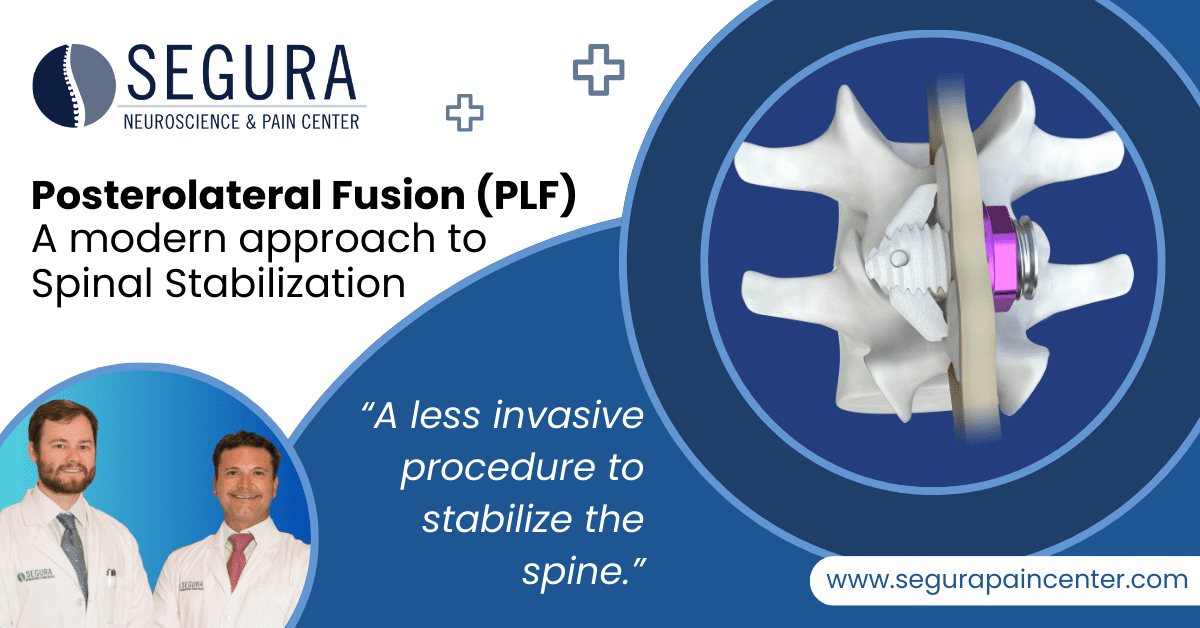
What is Posterolateral Fusion (PLF)?
How Does the PLF Device Work?
The PLF device plays a crucial role in stabilizing the spine and aiding in the fusion process. Here’s a simple breakdown of how it works:
- Precision and Design: The device is designed to fit well in different parts of the spine and comes in various sizes to match each patient's anatomy. It has a threaded post for easy placement during surgery, ensuring that it sits securely between the spinal bones.
- Bone Growth Promotion: The implant is coated with a special material that encourages bone growth, helping the spine segments fuse together over time. This fusion reduces unwanted movement between the vertebrae, alleviating pain and improving spinal stability.
- Stable Support: By keeping the spine from moving excessively, the device helps provide stability and support, allowing the patient to maintain more natural movement and reducing the risk of further injury.
Conditions Treated with PLF
PLF is particularly effective for conditions affecting the lumbar (lower) spine, including:
- Lumbar Spinal Stenosis: This condition involves the narrowing of the spinal canal, which puts pressure on the spinal cord and nerves, often leading to pain and discomfort.
- Lumbar Degenerative Disc Disease (DDD): DDD is characterized by back pain caused by the degeneration of spinal discs. PLF helps stabilize the affected area, reducing pain.
- Lumbar Spondylolisthesis: Commonly known as a "slipped disc," this condition occurs when a vertebra slips forward over the one below it. PLF stabilizes the spine and could correct and prevent further slippage.
How PLF Differs from Older Spinal Surgeries
Traditional spinal surgeries were often highly invasive, involving large incisions and significant disruption to the surrounding tissues and muscles. These procedures typically required long recovery periods and carried a higher risk of complications. PLF offers several key advantages, particularly in its approach and overall impact on the patient's body:
- Lateral Approach: Unlike other spinal fusion surgeries that use a posterior (from the back) or anterior (from the front) approach, PLF often employs a lateral (from the side) approach. This method allows surgeons to access the spine without cutting through the major muscles and tissues of the back or abdomen. By approaching the spine from the side, the procedure avoids disturbing the spinal cord and nerve roots directly, reducing the risk of nerve damage and leading to less post-operative pain and a quicker recovery.
- Minimally Invasive: The lateral approach also enables PLF to be performed in a minimally invasive manner. Smaller incisions are used, resulting in less blood loss, reduced muscle disruption, and a lower chance of infection. This is a significant contrast to traditional open surgeries, which involve larger incisions and more extensive tissue damage.
- Preservation of Spinal Structures: With the lateral approach, important structures like the supraspinous ligament are preserved. This ligament is crucial for maintaining spinal stability and integrity. In other fusion surgeries, these structures might be disrupted or removed, potentially affecting the spine's natural mechanics.
- No Need for Nerve Monitoring: Since the lateral approach avoids direct manipulation of the spinal cord and nerve roots, there is less need for intraoperative nerve monitoring, which is often necessary in traditional fusion surgeries to prevent nerve damage. This simplification reduces the complexity and duration of the procedure.
- Reduced Recovery Time: Patients who undergo PLF using the lateral approach typically experience shorter recovery times and less post-operative pain compared to those who have undergone traditional open spinal surgeries. This is due to the reduced tissue trauma and preservation of muscle integrity during the procedure.
Overall, the lateral approach used in PLF represents a more refined and patient-friendly technique for spinal fusion. It minimizes the invasiveness of the procedure, preserves critical spinal structures, and reduces recovery times, making it an attractive option for many patients needing spinal stabilization.
What to Expect with PLF Surgery
Patients undergoing PLF can expect a straightforward procedure that focuses on stabilizing the spine while minimizing disruption to surrounding tissues. Post-surgery, patients typically experience reduced pain as the spine fuses and stabilizes over time. The long-term prognosis for PLF patients is generally positive, with the implant designed to encourage bone growth and achieve a solid fusion.
Moreover, the implant used in PLF is MRI-compatible under specific conditions, allowing for ongoing monitoring and care without compromising the patient’s safety.
Discover How PLF Can Help You
Posterolateral Fusion (PLF) represents a significant advancement in spinal stabilization, offering a less invasive and more effective option for treating conditions like lumbar spinal stenosis, degenerative disc disease, and spondylolisthesis. By understanding how PLF works and how it differs from older surgical methods, patients can approach the procedure with greater confidence and a clearer expectation of the benefits and outcomes.
At Segura Pain Center, we specialize in less-invasive procedures, focusing on patient comfort and successful outcomes. With modern techniques like PLF, achieving spinal stability and pain relief is more accessible and less intimidating than ever before. Contact us today to learn more about how we can help you on your path to recovery.
About Dr. Segura

Ronald C. Segura, MD
Ronald C. Segura, MD is is double board certified in PM&R and Interventional Spine & Pain Medicine.
Dr. Segura attended LSU School of Medicine in New Orleans and completed a four-year residency training program in Physical Medicine & Rehabilitation. Dr. Segura's philosophy utilizes a multidisciplinary approach to healing pain. His treatment plan focuses on reducing pain and improving functional ability, which enhances one's quality of life.
About Dr. Robertson

Richard C. Robertson, Jr., MD
Richard C. Robertson, MD is is double board certified in anesthesiology and interventional pain management.
Dr. Robertson served as a board member of the Mississippi State Medical Association and was chosen to receive both the Virginia Stansel Tolbert Award and the Carl Gustav Evers Award for outstanding leadership. He chose to further specialize his training by completing an ACGME-accredited fellowship in interventional pain management at Wake Forest University Baptist Medical Center in Winston-Salem, NC.
This website is not intended to provide specific medical advice, medical diagnosis, opinion, treatment or services to you or to any other individual. Through this website and links to other websites, Segura Neuroscience & Pain Center provides general information for educational purposes only. The information provided in this site is not a substitute for medical or professional care. You should not use this information in place of the advice of your physician or other healthcare provider. Segura Neuroscience & Pain Center is not liable or responsible for any advice, course of treatment, diagnosis or any other information, services or product you obtain through this website.

